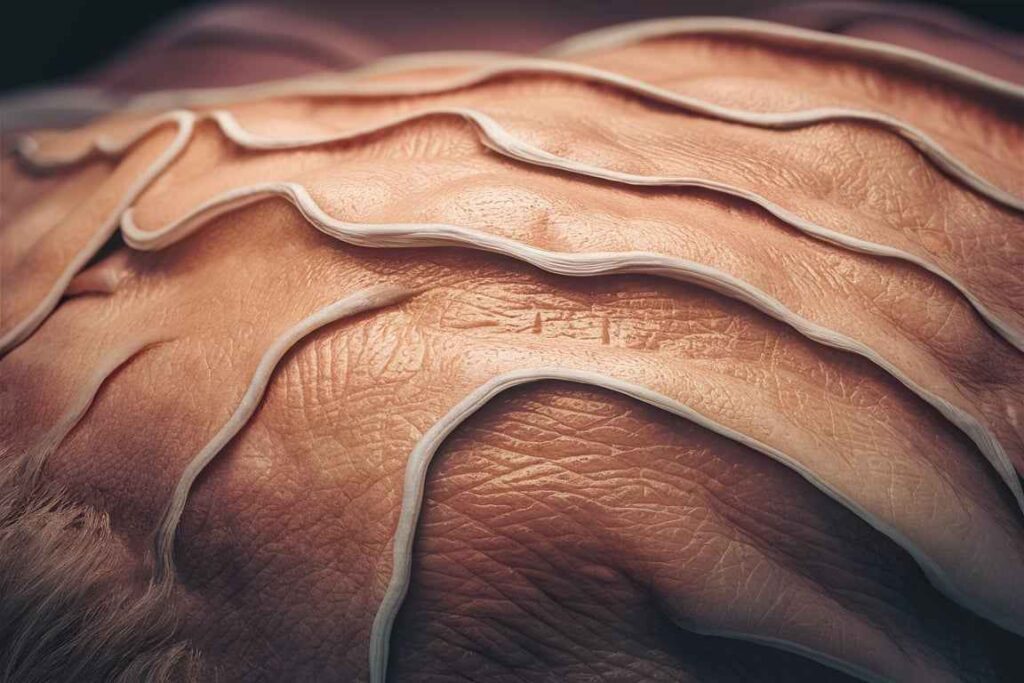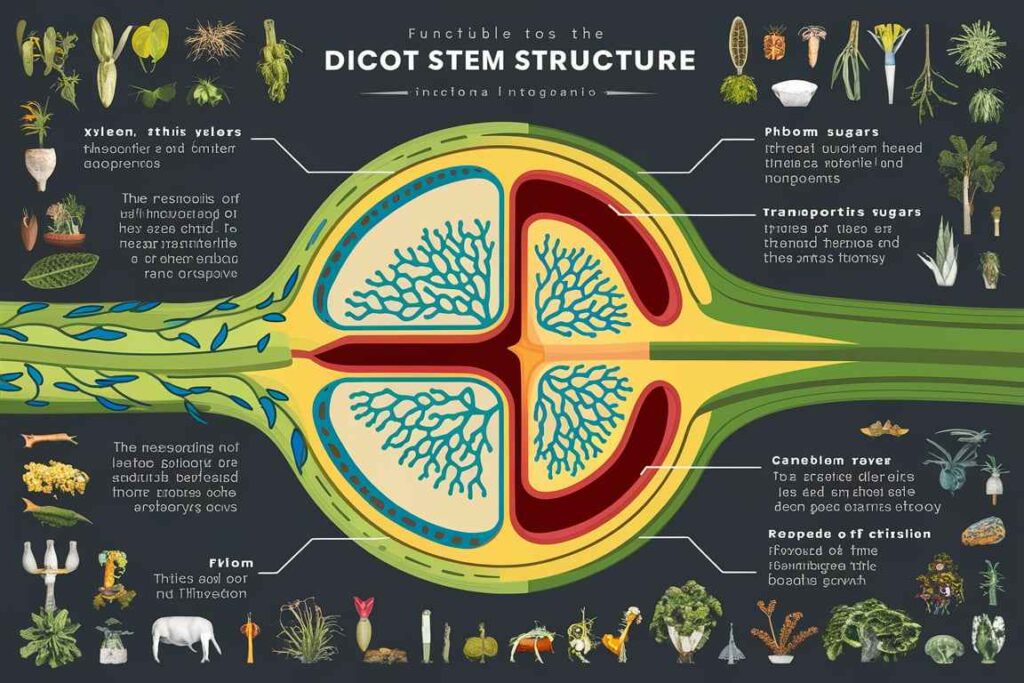Dicots stem, or dicotyledonous plants, are one of the two major categories of angiosperms (flowering plants), distinguished by the presence of two embryonic leaves, known as cotyledons. A dicot stem’s interior structure is different and complicated, designed to support a variety of purposes including water and nutrient movement, structural support, and storage. Understanding the structure of a dicot stem gives insight into the functional mechanisms and adaptations of these plants.
Table of Contents
Dicot stem
Dicot stems are the stem structures of dicotyledonous plants, generally known as dicots. Dicots are one of two principal types of angiosperms (flowering plants), distinguished by the presence of two embryonic leaves, or cotyledons, during seed germination. Dicot plants’ stems have a unique internal arrangement that promotes growth, nutrition transfer, and structural integrity.

General Features of Dicot Stems
Dicot stems often include the following characteristics:
- Vascular bundles form a ring.
- The presence of vascular cambium allows for secondary growth (an increase in girth).
- Differentiation into separate tissues such as epidermis, cortex, vascular bundles, and pith.
Detailed Structure of a Dicot Stem
A transverse section of a dicot stem reveals multiple distinct layers and tissues, each with unique functions:
Epidermis:
The outermost layer of the stem.
Made up of a single layer of tightly packed cells.
A waxy cuticle protects against water loss.
Stomata (pores) and trichomes (hair-like structures) may be present to facilitate gas exchange and protection.

Cortex:
It lies beneath the epidermis and extends into the pericycle.
Composed of many layers of parenchymal cells.
Functions include food storage, photosynthesis (if chloroplasts are present), and support.
Collenchyma cells may be present, providing additional support and flexibility, especially in immature stems.
Endodermis:
The deepest layer of the cortex.
Casparian strips, which are suberin-containing bands that govern the passage of chemicals into vascular tissues, are frequently present.
In stems, the endodermis is less defined than in roots.
Pericycle:
A layer of cells located directly inside the endodermis.
It can help produce lateral structures in stems, but it is less common than in roots.
Vascular bundles:
Forming a ring around the central pith.
Each vascular bundle is collateral (xylem and phloem are located side by side).
1. Xylem:
Located on the inside of the vascular bundle.
Transfers water and dissolved minerals from the roots to the remainder of the plant.
Made up of vessels, tracheids, xylem parenchyma, and xylem fibers.
2. Phloem
Located on the outside of the vascular bundle.
It transports organic nutrients, notably sucrose, from the leaves to the rest of the plant.
Made up of sieve tube elements, companion cells, phloem parenchyma, and phloem fibers.
Vascular Cambium:
Each vascular bundle contains a lateral meristem between the xylem and phloem.
Secondary growth is accomplished through the production of secondary xylem (wood) on the inside and secondary phloem on the exterior.
Continuous around the stem, producing an entire ring.
Medullary Rays:
Parenchyma cells stretch radially from the pith to the cortex.
Facilitate lateral transfer of nutrients and water.
Pith:
Located in the heart of the stem.
Comprised of parenchymal cells that store and transfer nutrients.
Often large and prominent in early stems, but may diminish in older stems as secondary growth occurs.
Functional Aspects of Dicot Stem Structure

The structure of dicot stems is highly adapted to their various functions:
(i) Support:
The ring of vascular bundles offers structural support, allowing the plant to remain erect and develop taller.
Collenchyma cells in the cortex provide flexibility and support for young, growing stems.
(ii) Transport:
Xylem vessels and tracheids efficiently transport water and minerals from the roots to the leaves and other parts of the plant.
Phloem sieve tube elements and partner cells help transfer organic nutrients throughout the plant.
(iii) Secondary Growth:
The vascular cambium produces secondary xylem and phloem, which help to thicken the stem over time.
This secondary growth boosts the plant’s ability to transmit water and nutrients while also providing additional support.
(iv) Storage:
Nutrients like as starch are stored in parenchyma cells in the cortex and pith and can be mobilized as needed.
(v) Protection:
The epidermis, with its waxy coating, guards the stem against desiccation and pathogen invasion.
Trichomes can provide protection from herbivores and direct sunshine.
Comparison with Monocot Stems
- Vascular Bundles: Dicot stems have vascular bundles arranged in a ring, while monocot stems have scattered vascular bundles.
- Secondary Growth: Dicots exhibit secondary growth due to the presence of vascular cambium, leading to an increase in girth. Monocots typically do not show significant secondary growth.
- Root System: Dicots generally have a taproot system, while monocots have a fibrous root system.
Significance of Dicot Stem Structure
The interior structure of dicot stems promotes the plant’s general growth and development, hence enhancing its ability to adapt to different conditions. The organization and differentiation of tissues ensures efficient transport, structural integrity, and storage, allowing dicots to thrive in a variety of environments.
Applications in Agriculture and Horticulture
- Breeding Programs: Understanding stem anatomy can help guide breeding programs aimed at generating crops with greater structural strength, nutrition delivery, and storage capacity.
- Pest and Disease Management: Understanding stem structure can help design ways to protect plants from pests and diseases, which frequently target specific tissues.
- Propagation Techniques: Understanding stem architecture is critical for creating effective propagation methods such as cuttings and grafting, which rely on the stem’s capacity to transport nutrients and water.
Frequently Asked Question
What is Dicot stem ?
Dicot stems are the stem structures of dicotyledonous plants, generally known as dicots. Dicots are one of two principal types of angiosperms (flowering plants), distinguished by the presence of two embryonic leaves, or cotyledons, during seed germination. Dicot plants’ stems have a unique internal arrangement that promotes growth, nutrition transfer, and structural integrity.
What are the functional aspects of Dicot Stem Structure ?
The functional aspects of Dicot Stem Structure are
(i) Support
(ii) Transport
(iii) Secondary Growth
(iv) Storage
(v) Protection
Related Article

